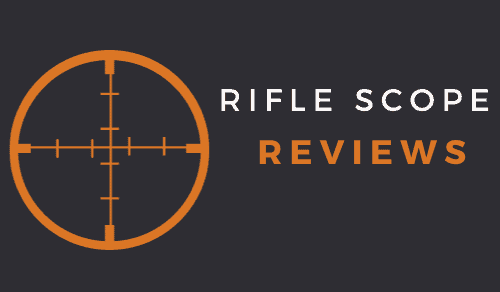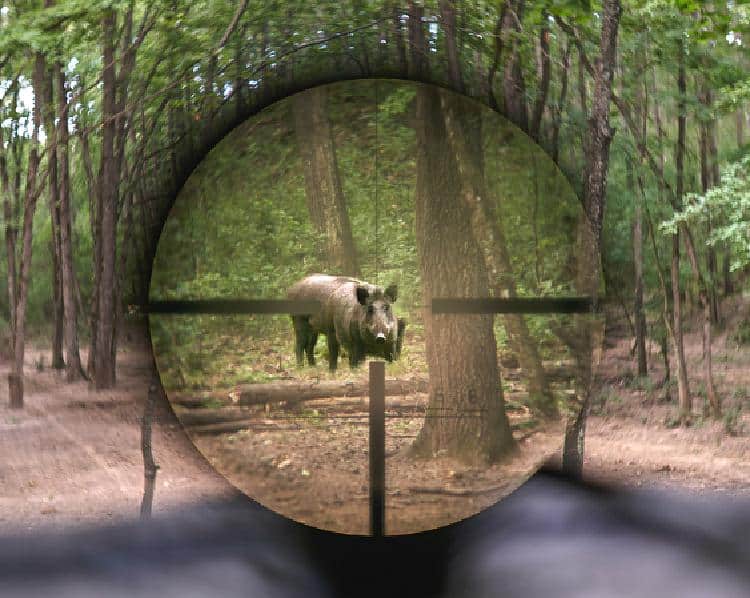As an Amazon Associate I earn from qualifying purchases. Amazon and the Amazon logo are trademarks of Amazon.com, Inc, or its affiliates.
When choosing a rifle scope, the reticle options available on a particular scope can play a big role in the purchasing decision. I’ve seen plenty of situations with customers at my day job where a specific scope model had every feature they wanted: ideal power range, the desired objective size, desired tube size, etc., but the reticle choices for that scope model ended being a deal-breaker. Heck, I make the same buying decision with scopes as well. I’m very particular about the reticle so it’s a big deal for me.
Vortex scopes are a big seller at my day job, and for good reason, as they offer a wide range of rifle scope options to address the needs of almost every shooter or hunter. As part of my job, I spend a decent about of time discussing and trying to answer questions about the various reticle options that Vortex offers. However, when discussing Vortex scope reticles, I spend quite a bit of time comparing the Vortex Dead Hold BDC vs Vplex reticles.
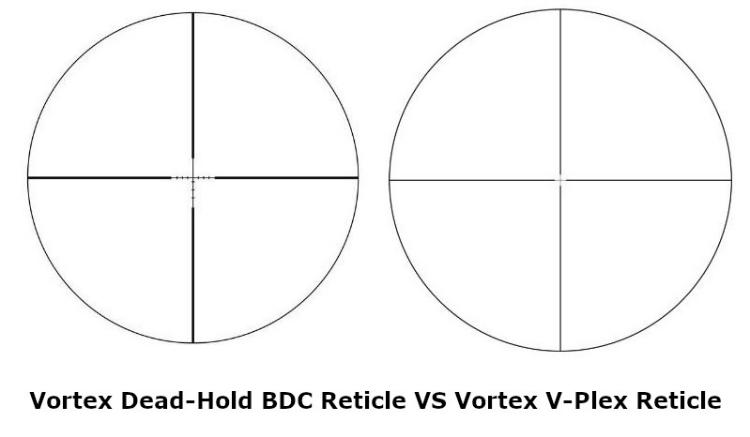 But, before I get into the specific details of comparing those two reticles, let’s start with some basics.
But, before I get into the specific details of comparing those two reticles, let’s start with some basics.
What does BDC stand for?
The BDC phrase is an acronym for Bullet Drop Compensation or Bullet Drop Compensator. This is a feature or device that helps compensate for the drop of the bullet as it travels specific distances. The drop of the bullet is part of the gravitational effect on the bullet and the amount of drop varies based on factors such as:
- Bullet caliber
- Bullet weight
- Distance traveled – The farther the distance traveled, the greater the drop.
- Bullet speed when it leaves the barrel
- Atmospheric conditions like altitude and temperature
A BDC reticle must be calibrated to a specific caliber and bullet weight traveling a specific preset distance at a known (constant) muzzle velocity.
In easy to understand terms, the BDC functionality is designed so a shooter who uses the specific data listed above (caliber, bullet weight, muzzle velocity) will know and be able to compensate for the drop of the bullet at known preset distances that are determined by the pre-configuration of the BDC function.
For example, if I am shooting a .22 caliber rifle with a .40 grain bullet that has a muzzle velocity of 1050 feet per second, I can use a BDC function built into a scope reticle to hit a target at 100 yards without doing any ballistic bullet drop math as the bullet drop is pre-configured for those specific variables via the BDC function.
BDC functionality built into rifle scope reticles is typically designed for shooting mid to longer ranges without having to know any other details other than the distance to target. The distance to the target will determine which of the bullet drop compensation markings on the reticle to use.
It’s basically an easier way to shoot longer distances without having to do ballistic-based mathematics.
Now BDC reticles are not perfect and have some downsides, but I’ll get into those a bit later.
Comparing the Vortex Dead Hold BDC reticle against the Vortex VPlex reticle
Vortex V-Plex Reticle
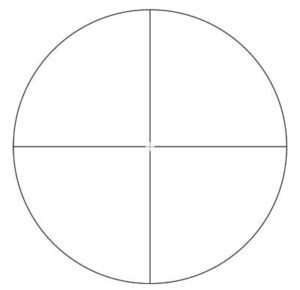 Over the years, Vortex’s V-Plex reticle has gone through a few changes. At one point, it was offered in a standard version and a V-Plex Wide version, but Vortex has since gone back to the standard V-Plex reticle option.
Over the years, Vortex’s V-Plex reticle has gone through a few changes. At one point, it was offered in a standard version and a V-Plex Wide version, but Vortex has since gone back to the standard V-Plex reticle option.
The V-Plex is a MOA based reticle that is basically Vortex’s version of the standard duplex reticle. It features slightly wider and darker horizontal and vertical posts, that narrow down to a finer line with a duplex-based crosshair.
The V-Plex is really a good, all-around reticle for most hunting and shooting applications. The downside with the V-Plex is the fact that it offers no options for longer range shooting, should the need arise. If the need arises, then the shooter will have to estimate the hold-over manually using the classic “Kentucky windage” method.
If you aren’t planning on doing any long-range shooting, or prefer a more traditional-based, simplistic reticle, then the V-Plex may be for you. It’s primarily a hunting-based reticle, although it works fine for most target shooting or plinking scenarios.
Pros and Cons of the V-Plex Reticle
| Pros | Cons |
|
|
Vortex Dead-Hold BDC Reticle
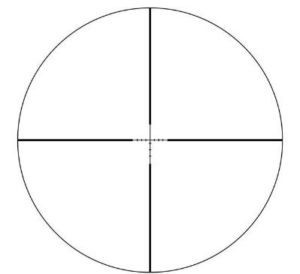 This reticle option has proven to be one of Vortex’s best-selling reticles, especially in the more budget-oriented scope families. While not specifically designated as “long range” reticle, the BDC functionality of this reticle does offer the shooter the ability to shoot longer distances.
This reticle option has proven to be one of Vortex’s best-selling reticles, especially in the more budget-oriented scope families. While not specifically designated as “long range” reticle, the BDC functionality of this reticle does offer the shooter the ability to shoot longer distances.
The Deadhold BDC reticle features a slightly thicker horizontal and vertical posts that taper down into a duplex-based reticle. This reticle also features 3 BDC based hash marks on the lower portion of the vertical post which are used for estimating holdover for longer shots, coupled with 3 hash marks on each side of the horizontal post and vertical post meeting point, which are used for estimating windage (left and right) corrections due to wind.
This reticle will work with most calibers and situations as Vortex breaks the BDC functionality into 4 firearms “classes”:
- Class A Firearms – Vortex lists the Class A firearms as rifles chambered in traditional high-power calibers like .270, .308, 30-06, etc. According to the Vortex BDC data, the effective BDC based range for those calibers is 100 yards to a max of 500 yards.
- Class B Firearms – The Class B firearms are rifles chambered in magnum calibers like .300 Win Mag, .338 Lapua, 7mm Mag, etc. According to the Vortex BDC data, the effective BDC based range for those calibers is 100 yards to a max of 600 yards.
- Class C Firearms – The Class C firearms are rifles chambered in high velocity smaller caliber cartridges like .204 Ruger, .22-250, 6.5 Creedmoor, etc. According to the Vortex BDC data, the effective BDC based range for those calibers is 100 yards to a max of 650 yards.
- Class D Firearms – Vortex identifies the Class D firearms as modern black power rifles in most any caliber. According to the Vortex BDC data, the effective BDC based range for those calibers is 50 yards to a max of 225 yards.
- Class E Firearms – The Class E classification includes rifles chambered in the .22 LR caliber. According to the Vortex BDC data, the effective BDC based range for that caliber is 25 yards to a max of 125 yards.
- Class F Firearms – The Class F designation includes shotguns using a slug barrel and traditional black powder rifles in various calibers. According to the Vortex BDC data, the effective BDC based range for those models is 25 yards up to a max of 125 yards.
In order for the BDC functionality to work properly, the shooter would need to sight the rifle or slug shotgun in at the distances recommended by Vortex. Those suggestions include the following:
- Class A – The suggested sight in distance is 100 yards.
- Class B – The suggested sight in distance is 200 yards.
- Class C – The suggested sight in distance is 200 yards.
- Class D – The suggested sight in distance is 100 yards.
- Class E – The suggested sight in distance is 50 yards.
- Class F – The suggested sight in distance is 50 yards.
Another point worth mentioning: There is a wide range of ballistic performance within the calibers of a Class as defined by Vortex, so the BDC functionality for each Class is a suggested range. It’s up to the shooter to test the specific cartridge they shoot (in conjunction with their preferred ammo) up against the recommended BDC hold-over positions to ensure their accuracy.
That basically a fancy way of saying the following: if you’re going to use the BDC functionality on the Dead-Hold BDC, then you need to test that BDC performance with your rifle and ammunition. Otherwise, you really won’t know exactly where the actual point of impact will be for that rifle as the specific BDC base distances.
Over the years, I’ve had a number of conversations with customers at my day job who bought a Vortex scope with the BDC reticle and returned to the store to complain that the BDC marks “were not accurate”. But, through further discussions, it turns out that those customers never followed Vortex’s suggestion of actually testing the POI (Point of Impact) of the BDC marks with their preferred caliber at the specific BDC based distances (in yards).
If you opt to use the BDC function, you’ll be way happier with the accuracy results if you invest the time to validate the BDC POI with your specific rifle or shotgun. Just zeroing the rifle or shotgun at the suggested BDC distance is not enough to ensure bullet drop accuracy.
The Vortex Dead-Hold BDC reticle can also be used for ranging targets, but, honestly, I much prefer to use a rangefinder. However, if you found yourself out in the field without a range finder, Vortex has a formula you can utilize in conjunction with the BDC points in the reticle to approximate the distance to a target.
And one last point to mention about BDC reticles in general, just because a BDC reticle platform says that using a specific BDC mark on the reticle to shoot 600 yards, doesn’t always mean that it’s ethical or practical to take a 600 yard shot, especially in a hunting scenario. Most every shooter has their own maximum effective shooting range, and it’s important to stay within that range. Obviously, with practice, one can extend the maximum range they are comfortable shooting as well.
Pros and Cons of the Vortex Dead-Hold Reticle
| Pros | Cons |
|
|
Between the Vortex V-Plex and the Vortex Dead-Hold BDC reticles, which is better?
The answer will really depend on a number of individual factors including:
- One’s personal reticle preferences
- Level of comfort shooting at longer distances
- The specific shooting or hunting scenario
Personally, between the two reticle options, I prefer the Dead Hold BDC reticle as I can run it as a standard duplex when needed, but also have the flexibility to extend my shooting ranges (within reason) if the need arises.
However, with that being said, I’m also the type of person who is willing to invest the extra time at the range to see exactly how the BDC performs at various distances.
But, if I were giving advice between the two reticles, I’d say the following:
- If you want an easy to use reticle where you just basically point and shoot, then the Vortex VPlex may be a better option for you.
- If you want the ability to stretch your shooting distances out a bit, and are willing to invest the time to validate the BDC options with your rifle and caliber, then the DeadHold BDC is definitely worth checking out as there’s a reason that the BDC reticle outsells the VPlex.
FAQS
Here are some frequently asked questions that I’ve both heard and read regarding the Vortex V Plex reticle and the Vortex Dead-Hold BDC reticle:
How Does the Vortex dead hold bdc reticle work?
The DeadHold BDC reticle is a reticle that features MOA based hash marks on the horizontal and vertical lines of the reticle.
Based on the rifle caliber, Vortex offers some guidelines about what range to sight the BDC based scope in. Once that has been done, you should be able to use the BDC marks as hold-over points when shooting at targets or game at longer distances.
For example, hypothetically with some rifle calibers, Vortex suggests that you zero the rifle in at 200 yards, so the center duplex is dead-on at 200 yards. For shooting at a 300-yard target, you would use the next hash mark down (vertically) from the duplex point. For a 400-yard shot, you would use the 2nd hash mark down, and so on with the bottom of the vertical post marking a hold over point for a 600-yard shot.
Again, as I’ve mentioned before, it’s imperative to validate the point of impact of your specific rifle and caliber with the proposed BDC based distances on the DeadHold BDC reticle.
I read that Vortex Optics offers an online BDC calculator for various calibers? Where can that information be located?
It sounds as though you are asking about the Vortex Long Range Ballistics Calculator application that Vortex offers. It can be accessed here: Vortex LRBC.
Does the Vortex LRBC application work with the Vortex Dead-Hold BDC reticle?
Yes and no. You can take the information that comes out of the LRBC application and use it to match your caliber specifications to the specific BDC hash marks in the reticle. It sounds complicated, but it’s really not. Here’s a great video that provides an excellent example:
What is a BDC scope?
A BDC scope is a rifle scope that has BDC (Bullet Drop Compensation) functionality built into the scope either via the scope reticle or via the scope turrets. This BDC functionality gives the shooter the ability to shoot at certain preset distances without having to calculate the drop of the bullet over the distance. Using a BDC scope, the bullet drop is preconfigured into either the reticle or turret.
It looks like not every Vortex rifle scope comes with the Dead-Hold BDC as a reticle option. Which of the Vortex scopes are available with the BDC reticle as an option?
You are correct that the Dead-Hold BDC reticle option is not available for every Vortex scope models. Only certain scope models offer the DeadHold BDC as a reticle option.
The Vortex Dead-Hold BDC reticle option is available in the following Vortex rifle scope families:
- Vortex Copperhead Scope series
- Vortex Crossfire II Scope series
- Vortex Diamondback Scope series
- Vortex Viper Scope series
- Vortex Viper HS Scope series
- Vortex Viper HS LR Scope series (Second Focal Plane models only)
Is the Vortex V-Plex reticle illuminated?
Unfortunately, the V-plex reticles are not illuminated. Vortex does offer some illuminated reticles, and the closest illuminated reticle option to the V-Plex reticle would be the Vortex V-Brite reticle.
If you prefer an illuminated Vortex reticle, here’s a link to all the Vortex scope models that are available with an illuminated reticle.
Does Vortex offer an illuminated version of the Dead-Hold BDC reticle?
Unfortunately, they do not offer the Dead-Hold BDC reticle in an illuminated version.
Can you use a scope with the DeadHold BDC reticle on a .22 rifle?
You certainly can, and Vortex even has a BDC based setting within their BDC manual specifically for the .22 LR caliber.
I’m interested in getting a Vortex scope with their BDC reticle, but I shoot a .223 and did not see the .223 specifically listed as a caliber that they support under their “Gun Classes”? Will their BDC not support a .223 or 5.56 caliber?
The Vortex Dead-hold BDC will absolutely support the 5.56 or .223 calibers. In terms of the Vortex Firearms Class for the BDC functionality, a .223/5.56 is classified as a Class C caliber.
However, you’re best bet is to go to the Vortex LRBC application I mentioned above, and follow the steps to configure your caliber specifics (bullet grain weight, speed, Ballistic coefficient, etc.), and then use that data to map your specific caliber/bullet performance to the Vortex BDC reticle.
Will the Vortex BDC scopes work for a shotgun shooting rifle slugs?
It absolutely will, and Vortex has a Firearms Classification within the BDC settings that is specifically designed for use with a shotgun shooting rifle slugs.
As I come across more questions or info about either of these two Vortex reticles, I’ll update this section.
I’ve been working in the firearms and sporting optics industry for over 20 years, with a personal and professional interest in all things related to rifle scopes, Through a combination of work experience, formal training, and personal experiences, I have extensive experience mounting, testing, and evaluating different rifle scope models across most major optical brands.
